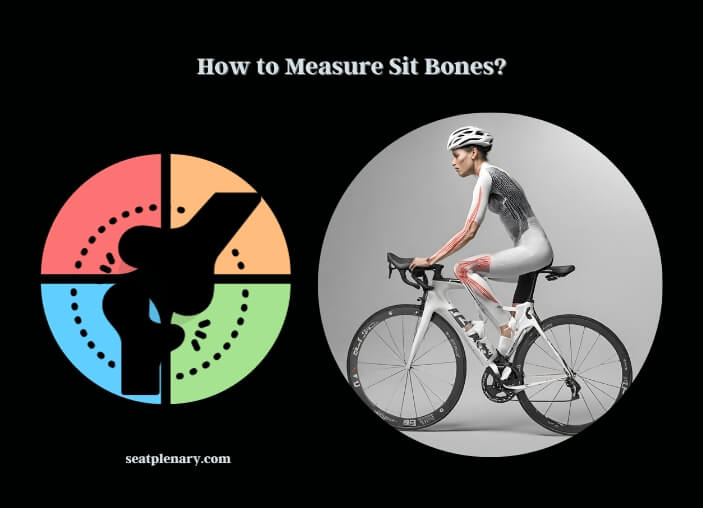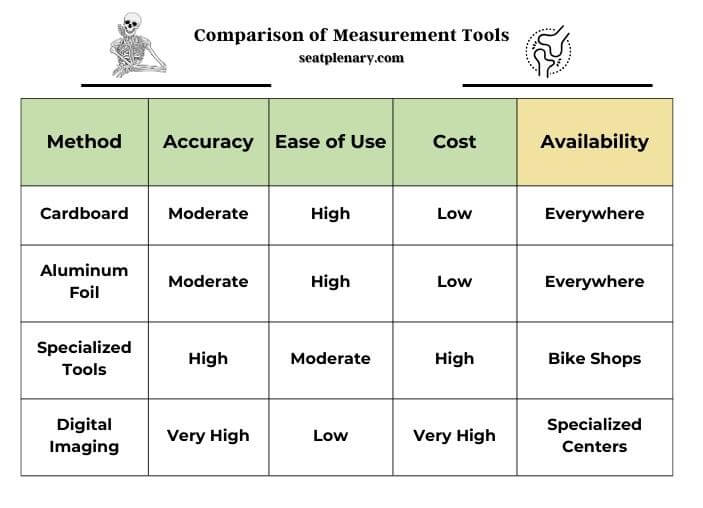Measuring sit bones is essential for finding the right bike saddle. The process involves determining the distance between the ischial tuberosities, commonly known as sit bones. This measurement ensures comfort and efficiency while cycling.
To measure sit bones, one effective method is using aluminum foil. Place a sheet of aluminum foil on a soft surface like a carpet or yoga mat. Sit on the foil with your weight evenly distributed, and then stand up. The imprints left on the foil represent your sit bones. Measure the distance between the centers of the two deepest impressions to find your sit bone width. This measurement is crucial for selecting the right saddle width, especially for those with sit bone widths of 120mm or 130mm, as specific saddle designs cater to these sizes.

Various tools are available for sit bone measurement. The specialized sit bone measurement tool, for instance, offers a precise way to determine this distance. These tools are often found at bike fitting centers or cycling shops. Searching for ‘sit bone measurement near me’ can help locate a nearby facility offering this service. It’s interesting to note that there’s no direct correlation between sit bone width and height. People of similar heights can have different sit bone widths, making personalized measurement vital.
Choosing the correct saddle width enhances comfort and performance. For instance, a saddle width for 120mm sit bones might differ significantly from one designed for 130mm sit bones. Ensuring the saddle matches your sit bone width can prevent discomfort and improve your cycling experience.
For more detailed insights and guidance on measuring sit bones and choosing the right saddle, we invite you to read the detailed article below. This information will aid in making an informed decision for a comfortable and efficient cycling journey.
How to Measure Sit Bones?
The Sit Bone Anatomy
Definition and Role of Sit Bones
Sit bones, or ischial tuberosities, are the hard bones you feel when sitting down. They play a crucial role in supporting your weight, especially when cycling. Knowing their exact location and how they affect your seating can transform your riding experience. It’s not just about comfort; it’s about harnessing the right support for your body.
Anatomical Variations in Sit Bone Structure
Every person’s sit bones are unique, like fingerprints. They vary in width, spacing, and even symmetry. This variation means that a one-size-fits-all approach to bike saddles just doesn’t work. Recognizing these differences is the first step in finding a saddle that feels like it’s made just for you.
Why Accurate Sit Bone Measurement Matters
Impact on Cycling Comfort and Efficiency
Getting the sit bone measurement right is key to a pain-free ride. A saddle that’s too narrow or too wide can lead to discomfort, reduced power, and even long-term health issues. It’s not just about the distance you cover, but how you feel while doing it.
Risks of Incorrect Saddle Fit
An ill-fitting saddle can cause more than just discomfort. It can lead to chronic pain, reduced blood flow, and even nerve damage. This is why cyclists, from casual riders to professionals, should pay close attention to their sit bone measurements.
Traditional Methods of Measuring Sit Bones
The Cardboard Method
The cardboard method is a simple yet effective way to measure your sit bones. Just sit on a piece of cardboard for a few minutes, stand up, and look at the indentations left behind. Measure the distance between the two deepest points, and voila, you have your sit bone width.
Using Aluminum Foil
Aluminum foil is another handy tool for measuring sit bones. Place a sheet on a soft surface, sit, and then stand. The foil will retain the shape of your sit bones, allowing you to measure the distance between them accurately.
DIY Techniques at Home
You don’t always need fancy equipment to measure your sit bones. Simple DIY methods using household items can be surprisingly effective. The key is to find a way to leave a clear, measurable imprint of your sit bones.
Advanced Tools and Technologies
Specialized Sit Bone Measurement Tools
For those seeking precision, specialized tools are available. These devices, often found in bike shops, use various technologies to measure sit bone width accurately, ensuring you get the perfect saddle fit.
Digital Imaging and Pressure Mapping
Cutting-edge methods like digital imaging and pressure mapping offer a detailed view of your seating position. These technologies provide insights beyond just sit bone width, like pressure points and posture.
Comparison of Measurement Tools
| Method | Accuracy | Ease of Use | Cost | Availability |
| Cardboard | Moderate | High | Low | Everywhere |
| Aluminum Foil | Moderate | High | Low | Everywhere |
| Specialized Tools | High | Moderate | High | Bike Shops |
| Digital Imaging | Very High | Low | Very High | Specialized Centers |

Data-Driven Insights on Sit Bone Width
Average Sit Bone Widths by Demographic
| Demographic | Average Sit Bone Width (mm) |
| Adult Male | 110 – 130 |
| Adult Female | 100 – 120 |
| Teenagers | 90 – 110 |
| Seniors | 100 – 130 |

Analyzing the Data for Better Saddle Selection
This data shows the diversity in sit bone widths across different groups. It highlights the need for personalized saddle choices to ensure comfort and efficiency in cycling.
Choosing the Right Saddle Based on Measurements
Saddle Width for Different Sit Bone Measurements
Selecting a saddle that matches your sit bone width is essential. A general rule is that the saddle width should be about 20-30mm wider than your sit bone width, providing the right balance of support and freedom.
Tailoring Saddle Choice to Individual Needs
It’s not just about width. Consider factors like riding style, flexibility, and personal preference. A saddle that suits your body and riding habits can significantly enhance your cycling experience.
Saddle Width Recommendations for Various Sit Bone Widths
| Sit Bone Width (mm) | Recommended Saddle Width (mm) |
| 100 | 120 – 130 |
| 110 | 130 – 140 |
| 120 | 140 – 150 |
| 130 | 150 – 160 |

Professional Assistance and Resources
Finding Expert Help for Measurement and Fitting
Sometimes, it’s best to seek professional help. Bike fitting experts can provide accurate measurements and recommend the perfect saddle. They can also adjust your bike to fit your body perfectly.
Online Resources and Local Bike Shops
There’s a wealth of information online, from detailed guides to interactive tools. Local bike shops are also great resources, offering both products and expertise to help you find your ideal saddle.
FAQs
Can Weather Affect Sit Bone Measurements?
Weather conditions, particularly temperature, can slightly affect sit bone measurements. In colder environments, your body naturally tenses up, which might lead to a narrower measurement. Conversely, in warmer settings, your muscles relax, potentially causing a slight increase in the distance between sit bones. While these changes are usually minimal, it’s best to measure your sit bones in a comfortable, room-temperature setting to ensure consistency and accuracy.
Is There a Difference in Sit Bone Width Between Cyclists and Non-Cyclists?
The width of sit bones is generally consistent across individuals, regardless of whether they are cyclists or not. The primary difference lies in the awareness and impact of this measurement. Cyclists tend to be more aware of their sit bone width due to the direct impact it has on their comfort and performance. Non-cyclists might not realize the importance of this measurement since they don’t engage in activities where sit bone discomfort is as apparent.
How Can Sit Bone Measurement Help in Choosing a More Comfortable Bike Seat?
Sit bone measurement is essential for improving bike seat comfort. By measuring the distance between your sit bones, you can find a bike seat that matches your unique anatomy. This will help distribute your weight evenly, reduce pressure points, and ultimately provide a more comfortable riding experience.
How Often Should I Re-measure My Sit Bones?
It’s a good idea to re-measure your sit bones if you experience significant changes in your body, such as weight loss or gain, or if you’ve undergone a physical transformation like pregnancy. Aging can also change your posture and body shape, which might affect sit bone spacing. For avid cyclists, re-measuring every few years is a good practice to ensure continued comfort and efficiency in riding.
Can Sit Bone Measurements Change Over Time?
Yes, sit bone measurements can change over time. Factors like aging, changes in physical activity levels, significant weight fluctuations, and even certain medical conditions can alter the spacing and positioning of your sit bones. This is why periodic re-measurement is recommended, especially if you’ve undergone notable physical changes.
Do Clothing and Padding Affect Measurements?
Clothing and padding can affect sit bone measurements. Thick or heavily padded clothing can create an inaccurate reading by adding extra width or not allowing a clear imprint of the sit bones. For the most accurate measurement, it’s advisable to wear thin, form-fitting clothing or to measure directly on the skin if privacy and comfort allow.
Can Incorrect Sit Bone Measurement Lead to Long-Term Health Issues?
While an incorrect sit bone measurement might not directly cause long-term health issues, it can lead to the use of an ill-fitting saddle. Over time, this can result in discomfort, chronic pain, and even issues like nerve compression or reduced blood flow. Consistent discomfort while cycling can also discourage physical activity, indirectly affecting overall health.
Are Sit Bone Measurements Different for Different Types of Cycling?
The fundamental sit bone measurements remain consistent regardless of the type of cycling. However, the type of cycling you engage in can influence the kind of saddle you might prefer. For instance, road cyclists might favor narrower saddles for better leg movement, while mountain bikers might need wider, more padded saddles for shock absorption. The measurement itself stays the same, but its application can vary based on cycling discipline.
Measuring your sit bones accurately is the foundation of a comfortable cycling experience. Whether you use simple DIY methods or advanced tools, understanding your sit bone width is key. It leads to better saddle choices, improved comfort, and a more enjoyable ride. Remember, the right saddle is out there, and it starts with knowing your measurements.
